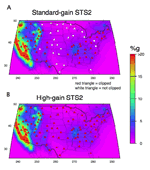
Abstract
Objective. In this document, we report the results of a study to determine if the Streckeisen STS2 high-gain seismometer is appropriate for use by the United States Geological Survey’s (USGS) Advanced National Seismic System (ANSS) for routine earthquake monitoring in the United States (US).
Issue. At issue is whether the high-gain STS2, with a sensitivity of 20,000 volts/meter/sec, can produce onscale recordings of earthquake activity within the continental US, or whether the low-gain STS2, with a sensitivity of 1500 volts/meter/sec, is more appropriate for earthquake monitoring due to the relatively lower input velocity required for clipping the recording system. The test ANSS backbone station configuration, considered in this study, consists of an STS2 broadband seismometer coupled to a Quanterra Q330 digitizer. The Q330 has a channel sensitivity of 4.19e5 counts/volt and a clip level of 8.38e6 = 8388608 counts (2e23) (20 volts). Therefore, an input ground velocity of only 0.001 m/sec will clip the high-gain system while an input ground velocity of 0.013 m/sec, a factor of 13 larger, is required to clip the lower-gain configuration.
|
